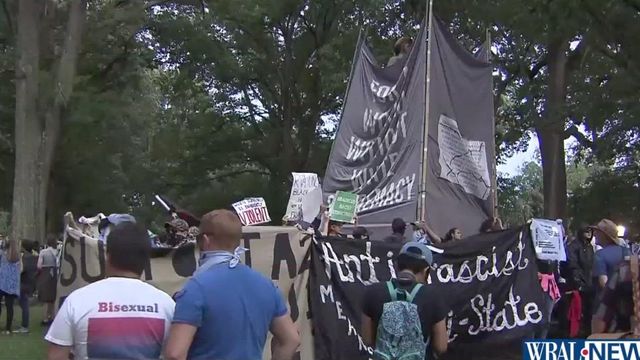Silent Sam review: New report analyzes UNC-CH response, suggests protocol changes
Nearly five months after the controversial "Silent Sam" Confederate statue was toppled on the campus of the University of North Carolina at Chapel Hill during an evening protest, a blue ribbon panel has present several recommendations on how the school should plan for and respond to campus protests.
Posted — UpdatedNearly five months after the controversial "Silent Sam" Confederate statue was toppled on the campus of the University of North Carolina at Chapel Hill during a summer evening protest, a blue-ribbon panel has concluded that "serious deficiencies" occurred up to and during the raucous rally.
The task force has outlined several recommendations on how the university should plan for and respond to future campus protests so as to minimize disruption and possible illegal behavior.
The findings were compiled by attorneys from the law firm of Parker Poe Adams & Bernstein and Hillard Heintze, a law enforcement management consulting group.
UNC officials issued a statement about the report.
“We appreciate the findings and recommendations brought forward by the After-Action Assessment Report," said Robert A. Blouin, executive vice chancellor and provost at UNC-CH. "We believe the learnings from this report will benefit not just Carolina, but other System institutions as well.”
The UNC Board of Governors commissioned the report to examine how the protest occurred and how UNC-CH administrators responded to the Aug. 20 demonstration that culminated with the statue being knocked from its pedestal.
"It should be noted that it is extremely fortunate no one was injured or killed when the statute was toppled," the report says, revealing publicly for the first time that an undercover police officer intervened to prevent anyone from being hurt as the statue came tumbling down. The group created a timeline of events that occurred before and during the protest.
The five key recommendations and findings in the report:
- Key decision makers should meet and discuss major campus events, and mandates that the university police chief must be empowered to directly contact the university's chancellor when a major event involving law enforcement is expected to occur on campus. The report says the chancellor should also take direct responsibility for reaching out to the chief directly and not relying on a chief of staff or other administrators to facilitate such communication. The report noted that because the police chief did not communicate directly to the chancellor about the expected Silent Sam protest, "miscommunication was allowed to proliferate."
- University police were not adequately staffed for Aug. 20. The report found that UNC-CH police did not fully understand or consider assistance from other local law enforcement agencies, including Chapel Hill police, despite the presence of a mutual aid agreement between the different jurisdictions. The report also found that officers' morale has plummeted in the wake of criticism about how the university responded to the Silent Sam protest.
- Information gathering about events should be managed by several officers. The report found that only one person, police Sgt. Jacob Kornegay, was out of town the weekend prior to the protest, leaving another officer to manage the event, which did not allow for the creation of "actionable intelligence" by several of the department's officers.
- The process the university employed to gather information about the protest was inefficient and inadequate. "Enough red flags existed prior to Aug. 20 to suggest that Silent Sam would be forcibly removed," the report says. The panel found that the university's police force "placed undue emphasis" on their own prior information gathering tactics even though it became clear that the make-up and crowd dynamics were changing. The report also found that officers relied too much on social media posts about the event despite questions about the reliability of the posts. The report then notes that some information share on social media was then ignored by university investigators. "In sum, information-gathering efforts were inefficient (in that vital intelligence was downplayed, ignored or inconsistently communicated) and inadequate (in that key-decision makers were operating without full and accurate information.) These failures culminated in the gross-underestimation of crowd size, which impacted University Police staffing, equipment, and overall preparedness."
- University officers were insufficiently trained in crowd control techniques. The panel concluded that officers couldn't say when they last trained about or studied crowd control techniques and tactics. The report found that there has been no required training of university police officers on crowd control for a number of years. "The lack of crowd control training meant that officers were ill-prepared to face the hundreds of demonstrators on Aug. 20, 2018, especially given that many of the protesters were non-student members of professional protest groups," the report found.
The report's authors said there was not a conspiracy among or between police, administrators and demonstrators to topple the statue that evening, but it was apparent that "UNC-CH struggled to communicate, prepare and execute their plans for the Aug. 20, 2018 demonstration, which ultimately resulted in the toppling of Silent Sam."
Related Topics
• Credits
Copyright 2024 by Capitol Broadcasting Company. All rights reserved. This material may not be published, broadcast, rewritten or redistributed.





